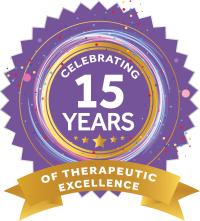by Sara Smith, MS, CCC-SLP
As an SLP and mom of a very active, just-turned-3 year old, I can say that early speech and language development is incredibly important to me. I want to ensure that my kiddo is supported in learning how to produce speech sounds correctly and in developing those critical pre-reading skills like Phonological Awareness.
Develop pre-reading skills
So what do I mean by pre-reading skills? Here are a few important ones:
- Interest in reading
- Basic language skills
- Phonological Awareness
Here is where I think many parents will say, “I know how to read books with my little one, and she has some basic language skills. But what is phonological awareness, and what am I supposed to do about that?!”
Phonological Awareness made fun!
First, let’s define this intimidating term.Phonological Awareness is simply the understanding that language has structure and patterns and that words can be broken down into smaller units. Phonological Awareness includes things like:
- being able to rhyme
- identifying words that start with the same letter/sound
- knowing the alphabet letters
- knowing the sounds that the letters make
- being able to break words apart or blend sounds together to say a word
These skills are obviously imperative for learning to read. Phonological awareness also helps children with their articulation. So if your child is in speech teletherapy or has difficulty producing certain sounds, you can also support them at home by working on these skills.But…there is a problem…if you are a parent of a toddler or preschooler, you don’t have time for ANYTHING else. Am I right, or am I right? 🙂
Phonological Awareness Activities
Good news is that there are some really quick and easy ways that you can help your child develop these important skills at home. Here are a few simple ideas that I have used successfully with my own toddler/preschooler:
ABC book scavenger hunt
I came up with this idea on the fly one Saturday during the pandemic lockdown. Parks were closed, we had exhausted all indoor activities, and I was desperate to get out of the house and keep my kiddo busy. For this activity all you need is sticky notes and an ABC book with pictures for each letter. You very likely have one of these in your house somewhere, but if not you can borrow one from your local library.Place a sticky note by each alphabet picture. Then take the book and a pencil along on your scavenger hunt. Look around your house, yard, or neighborhood for as many of the items as you can find from the picture book. Help your child use the pencil to make a check mark on the sticky note for each item you find.I am lucky enough to live by a walkable downtown, so I took my little guy on a stroller ride around town as we found items in shop windows or along the sidewalk.Therapist tip: As you complete the task, talk about what letter/sound each word starts with and help your child identify the corresponding alphabet letter in the book. This helps your child develop letter-sound correspondence and the ability to recognize words that begin with the same letter.
Silly word games
You don’t need any materials for this activity, and kids love it. No really! Simply make up silly rhymes or word change-ups while you are on the go. This activity also does double duty in that it not only helps your child develop phonological awareness skills but it is also a great distraction and mood booster.Here is what I mean.A common scenario at my house – my little guy is frustrated that I had to help buckle him into his carseat (because he really wanted to do it all by himself), then he realizes he is wearing his gray shoes and he really wanted to wear blue. In a nutshell, our day is going downhill fast.So I simply start making silly words as we drive, “Are you talking about your duckle, I mean wuckle, I mean buckle? Bucky, buckle, ducky, duckle!”I know it sounds silly, but this almost always distracts my toddler when needed and gets him giggling. After some practice, I can even say, “What if buckle started with an L, how would you say it then?” and he laughingly belts out, “Luckle!”.Therapist tipThis activity makes for a great distraction for little ones, and it also helps in developing key phonological awareness skills, such as rhyming and sound manipulation. If your child is having difficulty producing certain speech sounds, you can even use this time to practice the target sound while making silly rhymes.
Letter of the day
This activity is highly adaptable depending on what materials you have handy. When creating this activity in my own home, I have used a set of magnet letters, a food tin, and some small toys/objects.So here is how we do “Letter of the day” at our house.I choose a magnet letter and stick it to a metal food tin that I happened to have in the back of a cabinet. Then I grab a small object or toy that begins with that letter and put it inside the tin.For example, for the letter M, I might put a toy wind-up mouse or a pair of mittens inside the tin. This seriously takes all of 5 minutes to put together, and is easy to do once your kiddo has gone to bed.Then in the morning your child can discover the letter and open the tin to find the object inside. You can talk with your little one about the letter and the sound the letter makes. Help her to recognize that letter in books or signs as you go about the rest of your day. You can even try to draw the letter, cut it out with paper, or use dry cereal to create the letter on the child’s plate or high chair tray.We certainly don’t do a letter of the day every day at our house, but I can easily bust it out when I feel like my kiddo needs some extra stimulation, or if he needs to work on a particular letter-sound.Therapist tipThis activity is great for building alphabet awareness and letter identification. Help your child develop these skills by bringing their attention to letters and their corresponding sounds across various environments, such as during book reading at home. You can also challenge them to try to spot the letter while out and about in the community.These are just a few simple tactics that have come in handy for me as an SLP and mama. You can tailor them to suit your specific needs and the materials you have on hand. If your child is receiving speech teletherapy, your SLP can provide you with even more recommendations for activities that are individualized to your student’s particular needs.
About the Author
 Sara Smith, MS, CCC-SLP is a Speech Language Pathologist and Lead Product Manager with E-Therapy. She has worked extensively with children and adults on the autism spectrum in schools, group homes, private clinics, and via teletherapy. Sara has extensive experience in the teletherapy space providing trainings and support for a variety of therapists, including SLPs, OTs, PTs, and mental health professionals. She has presented nationally on best practices for teletherapy in the fields of speech pathology, early education, and telemental health.
Sara Smith, MS, CCC-SLP is a Speech Language Pathologist and Lead Product Manager with E-Therapy. She has worked extensively with children and adults on the autism spectrum in schools, group homes, private clinics, and via teletherapy. Sara has extensive experience in the teletherapy space providing trainings and support for a variety of therapists, including SLPs, OTs, PTs, and mental health professionals. She has presented nationally on best practices for teletherapy in the fields of speech pathology, early education, and telemental health.

